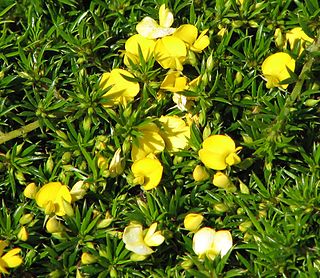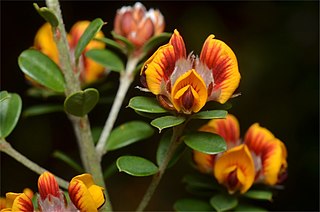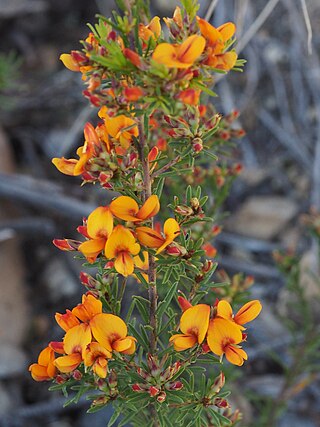
Pultenaea gunnii, commonly known as golden bush-pea, is a species of flowering plant in the family Fabaceae and is endemic to south-eastern Australia. It is a slender, erect to spreading shrub with hairy young stems, egg-shaped to lance-shaped leaves with lance-shaped stipules at the base, and bright yellow and dark red flowers.

Pultenaea juniperina, commonly known as prickly bush-pea or prickly beauty is a species of flowering plant in the family Fabaceae and is endemic to south-eastern Australia. It is an erect, spiky shrub with hairy stems, linear to narrow elliptic leaves with stipules at the base, and yellow-orange and red flowers.

Pultenaea pedunculata, commonly known as matted bush-pea, is a species of flowering plant in the family Fabaceae and is endemic to south-eastern Australia. It is a prostrate, densely matted shrub with softly-hairy branches that often form roots, narrow elliptic leaves, and bright yellow and brick-red flowers.

Pultenaea aristata, commonly known as bearded bush-pea or prickly bush-pea, is a species of flowering plant in the family Fabaceae and is endemic to New South Wales. It is a small, erect shrub with linear to narrow elliptic, sharp-tipped leaves, and yellow and red flowers.
Pultenaea baeuerlenii, commonly known as Budawangs bush-pea, is a species of flowering plant in the family Fabaceae and is endemic to a restricted area of New South Wales. It is a small, erect shrub with linear, cylindrical, grooved leaves, and dense groups of yellow and red flowers, sometimes with red markings.

Pultenaea daltonii, commonly known as hoary bush-pea, is a species of flowering plant in the family Fabaceae and is endemic to western Victoria, Australia. It is a spreading shrub with cylindrical leaves, grooved on the upper surface, and clusters of yellow flowers with red markings.

Pultenaea glabra, commonly known as smooth bush-pea, is a species of flowering plant in the family Fabaceae and is endemic to eastern New South Wales. It is an erect shrub with glabrous stems, linear to egg-shaped leaves with a concave upper surface, and yellow to red and orange flowers.
Pultenaea lapidosa is a species of flowering plant in the family Fabaceae and is endemic to south-eastern Australia. It is an erect to low-lying shrub with linear to narrow elliptic leaves and deep orange and dark red flowers.

Pultenaea laxiflora, commonly known as loose-flower bush-pea, is a species of flowering plant in the family Fabaceae and is endemic to south-eastern continental Australia. It is a low-lying to prostrate, spreading shrub with linear to narrow egg-shaped leaves with the narrower end towards the base, and yellow and red to brown or purple flowers.

Pultenaea luehmannii, commonly known as thready bush-pea, is a species of flowering plant in the family Fabaceae and is endemic to the Grampians National Park. It is a diffuse, more or less prostrate sub-shrub with trailing branches, narrow elliptic leaves, and orange and dark brown flowers.
Pultenaea maidenii, commonly known as Maiden's bush-pea, is an extinct species of flowering plant in the family Fabaceae and was endemic to Victoria, Australia. It was an erect shrub with egg-shaped leaves with the narrower end towards the base, and pea-shaped flowers.

Pultenaea maritima, commonly known as coastal bush-pea or coastal headland pea, is a species of flowering plant in the family Fabaceae and is endemic to eastern Australia. It is a prostrate, mat-forming shrub with elliptic, or oblong to spatula-shaped leaves and pea-like flowers.

Pultenaea parrisiae, commonly known as bantam bush-pea, or Parris's bush-pea, is a species of flowering plant in the family Fabaceae and is endemic to south eastern continental Australia. It is a low-lying sub-shrub with linear to lance-shaped leaves with the narrower end towards the base, and yellow to purple flowers with red markings.

Pultenaea parviflora, sommonly known as Sydney bush-pea, is a species of flowering plant in the family Fabaceae and is endemic to eastern New South Wales. It is usually a small, erect shrub with wedge-shaped to narrow egg-shaped leaves with the narrower end towards the base, and clusters of yellow to orange and red flowers.

Pultenaea petiolaris, commonly known as woolly bush-pea, is a species of flowering plant in the family Fabaceae and is endemic to eastern Australia. It is a low-lying shrub with linear leaves, pea-like flowers and flattened fruit.

Pultenaea spinosa, commonly known as grey bush-pea or spiny bush-pea, is a species of flowering plant in the family Fabaceae and is endemic to south-eastern continental Australia. It is a low-lying to erect shrub with glabrous stems, egg-shaped to rhombic leaves, and yellow-orange and red, pea-like flowers.

Pultenaea stricta, commonly known as rigid bush-pea, is a species of flowering plant in the family Fabaceae and is endemic to south-eastern continental Australia. It is a slender, erect or low-lying shrub with elliptic to egg-shaped leaves with the narrower end towards the base, and yellow and red, pea-like flowers.
Pultenaea trichophylla, commonly known as tufted bush-pea, is a species of flowering plant in the family Fabaceae and is endemic to South Australia. It is a slender, prostrate to erect shrub with hairy branchlets, lance-shaped leaves, and yellow to orange and red, pea-like flowers.
Pultenaea victoriensis is a species of flowering plant in the family Fabaceae and is endemic to a restricted area of Victoria, Australia. It is a shrub with hairy young stems, wedge-shaped to oblong leaves with a notched tip, and yellow and dark red, pea-like flowers.

Pultenaea campbellii commonly known as New England bush-pea or ragged bush-pea, is a species of flowering plant in the family Fabaceae and is endemic to New South Wales. It is an erect shrub with linear leaves and yellow-orange flowers arranged near the ends of branchlets.
















